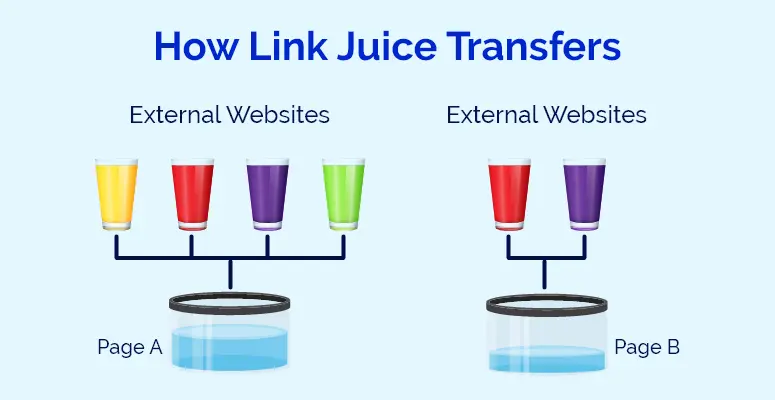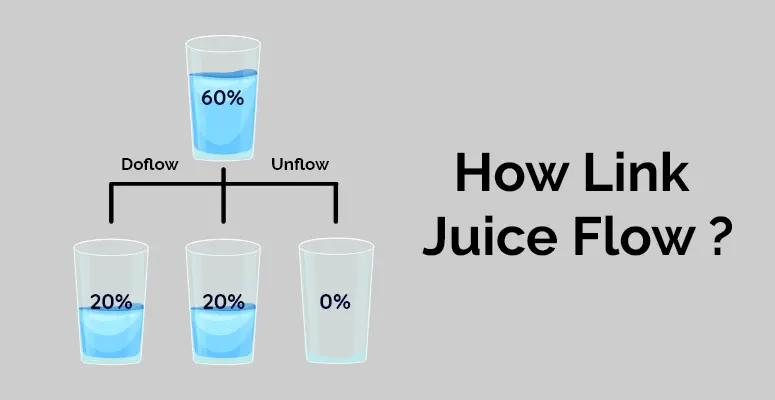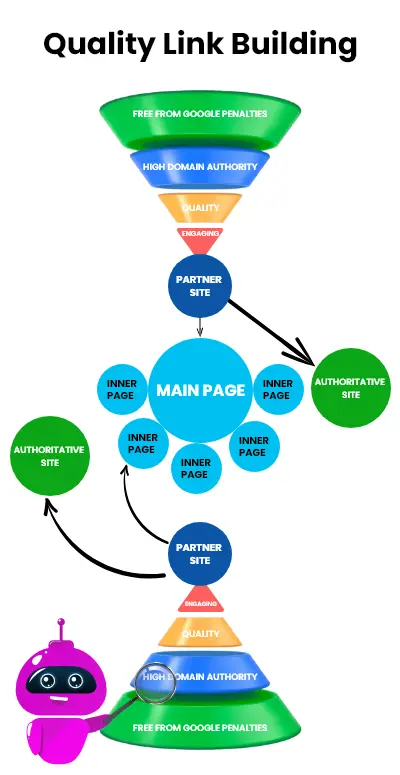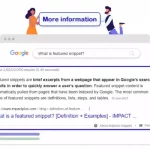
Once upon a time, there was a website owner named John who had a dream of reaching the top of the search engine rankings.
He worked tirelessly on his website’s content and design, hoping that visitors would come flooding in.
But alas, his website remained buried under the millions of other pages on the internet, invisible to potential customers.
One day, John stumbled upon the concept of “link equity” or “link juice” in SEO, and his whole world changed.
He discovered that search engines like Google use complex algorithms to analyze the links pointing to his website and determine its authority and relevance.
Suddenly, John realized that the key to unlocking his website’s potential was not just in creating great content. But, in building high-quality links from other authoritative websites.
He learned that link equity was like a currency in the world of SEO, and the more he earned, the higher his website would climb in the search engine rankings.
So, are you also one of those who want to take their website to the top of search engine rankings? Let’s dive deeper into the mysterious world of link equity.
What is Link Equity Or Link Juice?
Link equity is a crucial concept in search engine optimization (SEO) that refers to the value or authority passed from one web page to another through hyperlinks.
Essentially, when a website links to another website, it is like giving a vote of confidence or endorsement that the linked-to site has valuable content.
Google takes link equity in SEO as one of the key elements to determine a website’s relevance and authority in a given topic or niche. The more high-quality links a website has pointing to it, the more likely it is to appear at the top of search results.
Simply, link equity or link juice in SEO is a fundamental concept that plays a noteworthy role in determining a website’s authority and relevance.
By understanding how link equity in SEO works and focusing on building high-quality links, website owners can improve their search engine rankings and achieve their SEO goals.
Link juice is passed from one page to another through hyperlinks. When a website links to another website, it passes some of its link juice to the linked site. The amount of link juice passed depends on the authority and relevance of the linking page.
There are types of link juice or link equity:
External Equity Links:
External equity links originate from other websites and point to your website. These links are crucial for building link equity in SEO as they pass value and authority from one website to another.
External equity links from high-quality and relevant websites can greatly improve your search engine rankings and drive traffic to your website.
Internal Equity Links:
Internal equity links originate from one page on your website and point to another page on your website.

Internal links can help search engines understand the relevance and hierarchy of your website’s pages. They can also improve the user experience by providing additional information and helping users navigate your website.
12 Indicators of High-Quality Backlinks for Link Equity
In order to build high-quality backlinks that will positively influence your website’s search engine rankings, pay attention to several key indicators.
These indicators include relevant anchor text, site authority, follow vs. no-follow links, crawlability, link location, link quantity vs. quality, content quality, guest blogging, broken link building, social signals, brand mentions, and trustworthiness.
Let’s see a few indicators:
Relevant Anchor Text: Don’t Get Lost in Translation
Anchor text is the visible, clickable text in a hyperlink. Relevant anchor text refers to using keywords or phrases that accurately describe the content of the linked page.
When the anchor text is relevant, it can improve a website’s link equity and SEO by providing context and relevance to search engines.
Here are some best practices for using relevant anchor text to improve link equity:
- Use descriptive anchor text: Use descriptive and relevant anchor text that accurately describes the content of the page being linked to. This helps search engines understand the context of the linked page and can improve their search engine rankings.
- Avoid over-optimizing anchor text: Avoid using exact-match or repetitive anchor text, as search engines might consider it spammy and can lead to penalties. Instead, use natural and varied anchor text that describes the linked page.
- Vary your anchor text: Use different anchor text phrases and keywords when linking to a page that can improve the link equity of the linked page and help to avoid over-optimizing anchor text.
- Consider the context: When creating anchor text, consider the context and surrounding content of the link. Use anchor text that is relevant to the overall topic and provides additional context to readers.
Using relevant anchor text improves a website’s link equity and SEO. It helps search engines understand the context of linked pages and can improve their search engine rankings.
Therefore, it’s better to use descriptive, varied, and natural anchor text that accurately describes the linked page content while avoiding over-optimization.
Site Authority: How to Link Up with the Big Shots
Site authority is a critical aspect in determining the search engine ranking of a website. It measures the credibility and trustworthiness of a website based on several factors, including domain age, content quality, and the number of inbound links.
Websites with high authority are more likely to rank higher in search engine results pages, which makes it crucial for website owners to consider ways to increase their site authority.
Today, One of the most effective ways digital marketers use to increase site authority is acquiring high-quality backlinks from other authoritative websites.
When a high-authority website links to your website, it signals to search engines that the website is trustworthy and credible. This, in turn, can lead to improved search engine rankings and increased traffic to your website
To acquire backlinks from authoritative websites, you must identify potential linking opportunities within your niche or industry. Start by identifying websites already linking to your competitors and reach out to them to request a backlink to your website.
Secondly, creating high-quality content that is shareable and linkable. When your content is useful, informative, and engaging, more users will share it on social media and link to other websites.
This, in turn, will increase the number of inbound links to your website and improve your site authority.
When building backlinks, ensure links are relevant and contextually appropriate implying that the content surrounding the link should be related to the content on your website.
Additionally, avoid using spammy or manipulative tactics to acquire backlinks, as this can result in penalties from search engines.
In addition to building high-quality backlinks, several other aspects can contribute to site authority. These include creating a strong internal linking structure, optimizing website speed and performance, and ensuring your website is mobile-friendly.
By focusing on these, you can improve your site authority and increase your chances of ranking higher in search engine results pages (SERPs).
Follow vs. No-Follow: A Link’s True Colors
Link equity is essentially the value passed from one page to another through links. When a high-authority website links to your website, it passes some of its link equity to your website, which can help to improve your own site authority and search engine rankings.
Follow links are a critical part of building link equity and improving the SEO of your website.

It’s necessary to note, however, that not all follow links are created equal.
The value of a follow link depends on several parameters, including the authority and relevance of the linking page, the context of the link, and the anchor text used for the link.
For example, a follow link from a high-authority website that is relevant to your niche and uses relevant anchor text is likely to be more valuable than a follow link from a low-authority website that is not relevant to your niche and uses generic anchor text.
Also, there are sponsored and UGC (user-generated content) links. Sponsored links are those paid for, while UGC links are created by users, such as in forum posts or comments.
Both sponsored and UGC links should be no-follow links to comply with search engine guidelines.
Crawlability: Don’t Let Your Links Get Lost in the Web
Crawlability is the ability of search engines to discover and access the content on your website, including your backlinks.
If search engines are unable to crawl your website, your backlinks may not be discovered and may not influence your link equity or search engine rankings.
Several factors can affect the crawlability of your website, including technical issues like broken links or server errors, as well as content-related issues like duplicate content or thin content.
As a digital marketer, you should regularly monitor your website for crawl errors to ensure that search engines can discover and access your content.
Moreover, having a clear and logical site structure, with relevant categories and subcategories, can help search engines understand the context of your content and make it easier for them to crawl and index your pages.
Link Location: Why Placement Matters
The location of your backlinks on the linking page can add or reduce the value of your link equity. The most valuable backlinks are those prominently featured on the linking page, such as within the main content area or header of the page.
Backlinks that are buried within the footer, sidebar, or low-quality content areas of the linking page are generally less valuable and may have little to no impact on your link equity or search engine rankings.
This is because search engines prioritize links that are prominently featured and contextually relevant to the content on the linking page.
Also, context of the linking page and the relevance of the content surrounding the backlink play an essential role in determining the value of the link.
Backlinks placed within relevant and high-quality content are generally more valuable than those placed within low-quality or unrelated content.
The placement of your backlinks should never come at the expense of user experience or the quality of the linking page. Backlinks placed in a way that feels unnatural or manipulative can harm your link equity and search engine rankings.
When building backlinks, focus on building high-quality links that are contextually relevant and placed in a way that feels natural and valuable to the linking page and its users.
By prioritizing quality and relevance over quantity and placement, you can build a strong backlink profile that supports your overall SEO strategy and drives valuable traffic to your website
Link Quantity vs. Quality: Which One Matters More?
When it comes to building a strong backlink profile and improving your website’s SEO, the age-old question of link quantity vs. quality often comes up.
The truth is, both link quantity and quality are important elements to consider when building a strong link juice profile.
Link quantity refers to the number of backlinks pointing to your website, while link quality refers to the relevance, authority, and trustworthiness of the websites linking to your site.
In the past, the quantity was often prioritized over quality, and webmasters would focus on building as many links as possible, regardless of their relevance or quality.
However, search engine algorithms have evolved to prioritize quality over quantity, and low-quality or spammy backlinks can actually harm your website’s search engine rankings and overall link equity.

While a diverse and robust backlink profile, focusing solely on link is something that can’t be ignored, quantity can actually do more harm than good. Instead, webmasters should prioritize building high-quality backlinks from relevant and authoritative websites in their industry or niche.
When building backlinks, focus on building relationships with other websites in your industry, creating high-quality content that naturally attracts links, and prioritizing relevance and authority over sheer quantity.
That being said, consider the volume of backlinks you’re building and ensure you’re building enough links to support your overall SEO strategy.
While quality is key, a diverse and well-rounded backlink profile that includes a mix of high-quality, relevant backlinks can help improve your website’s overall link equity and search engine rankings.
Content Quality: The Foundation of Link Equity
The quality of the content on the page being linked to is also a substantial factor in determining the value of a backlink.
High-quality content that provides value to users is more likely to attract backlinks from other websites, and those backlinks will be more valuable.
Imagine having a magic wand that could instantly boost your website’s traffic and leads. Well, you don’t need a wand because the answer lies in creating high-quality content!
By producing content that is informative, engaging, and unique, you’re not only attracting visitors to your site but also building link equity.
The more content you create, the more link equity you’ll have. According to a HubSpot study, companies that publish 11 or more blog posts per month receive almost 3.5 times more traffic and 4.5 times more leads than those that publish only zero to four posts per month.
So, get your thinking caps on and start producing amazing content that will bring traffic pouring into your website like a flood!
Guest Blogging: A Bridge to Stronger Backlinks
Guest blogging involves creating content for other websites in your industry or niche, including a backlink to your website within that content.
This can be a valuable way to build high-quality backlinks, as long as the content you create is relevant, histratggh-quality, and provides value to readers.
Not only does it allow you to showcase your expertise and knowledge on other websites, but it can also lead to some serious SEO benefits. A study by Ahref found 60% of bloggers write one to five guest posts per month
So don’t be afraid to put yourself out there and start guest posting – your website’s link equity will thank you!
Broken Link Building: Finding the Silver Lining
Broken link building is a white hat SEO strategy that involves finding broken links on other websites and using those opportunities to suggest a replacement link to your website.
This strategy is based on the principle that website owners would prefer to replace broken links on their site with relevant and valuable content rather than leaving their readers with a dead end.
The process of broken link building typically involves the following steps:
- Finding and evaluating broken links: Once you’ve identified a website with broken links, you need to evaluate whether the broken link is worth pursuing. You can use tools like Ahrefs and Serpple to determine the page’s authority, traffic, and relevance to your niche. If the broken link is on a high-quality website with relevant content, it may be worth pursuing.
- Creating relevant content: Before you reach out to the website owner, you need to create relevant and valuable content that can serve as a replacement for the broken link. Your content should be high-quality, informative, and relevant to the page where the broken link is located.
- Contacting website owner: Once you’ve created your content, you need to reach out to the website owner and let them know about the broken link. You can use email or social media to contact them and offer your content as a replacement. Be sure to explain why your content is relevant and valuable to their readers.
- Follow-up: If you don’t hear back from the website owner, you should follow up with a friendly reminder. Persistence is key when it comes to broken link building, as it can take several attempts to get a response.
Broken link building can be an effective way to build high-quality backlinks to your website, as long as you’re providing relevant and valuable content.
By identifying broken links on high-quality websites and offering your content as a replacement, you can improve your website’s search engine rankings and drive more organic traffic to your site.
Social Signals: The Power of Sharing
Social signals are interactions on social media platforms like likes, shares, comments, and other types of engagement that a website’s content receives.
While they do not directly affect a website’s link equity, they can have a significant impact on a website’s search engine rankings by increasing its visibility and reach.
When content is shared on social media, it can be seen by a wider audience, making it more likely to be linked to other websites. This, in turn, can improve the website’s backlink profile and enhance its search engine rankings.
Additionally, social signals can help to establish a website’s authority and credibility within its niche. When a website’s content receives a lot of social signals, it signals to search engines that the content is high-quality, relevant, and valuable to its audience.
This can lead to higher search engine rankings and increased organic traffic to the website.
Therefore, website owners need to focus on creating content that is shareable on social media and actively engaging with their audience on these platforms.
By doing so, they can improve their website’s SEO and drive more traffic to their site.
Brand Mentions: How They Affect Your Link Equity
Brand mentions referring to instances where a brand is mentioned on another website without a link. While they do not provide a direct link to a website, brand mentions can still have a positive impact on a website’s link equity and SEO.
When a brand is mentioned on another website, it signals to search engines that the brand is authoritative and credible within its niche.
This can lead to increased brand awareness and can also lead to more backlinks over time, as website owners may decide to link to the brand’s website if they see that it is being mentioned frequently.
Here are some ways that brand mentions can impact a website’s link equity:
- Improved brand awareness: When a brand is mentioned on other websites, it can increase its visibility and awareness among its target audience. This can lead to more traffic to the brand’s website and improved engagement with its audience.
- Increased backlinks: When a brand is mentioned frequently on other websites, it can lead to more backlinks over time. Website owners may decide to link to the brand’s website if they see that it is being mentioned frequently and if they believe that the brand’s website provides value to their audience.
- Improved search engine rankings: When a brand is mentioned frequently on other websites, it can improve its search engine rankings. Search engines use brand mentions as a ranking factor, as they signal to search engines that the brand is authoritative and credible within its niche.
- Building relationships with other website owners: When a brand is mentioned on other websites, it can help to build relationships with other website owners. This can lead to more opportunities for collaboration and can help to increase the brand’s visibility and reach.
Trustworthiness: Why it Matters More Than Ever
With search engine algorithms becoming more sophisticated, trustworthiness is becoming increasingly important to determine a website’s search engine rankings.
Backlinks from trustworthy, reputable websites can help increase your website’s trustworthiness and authority, while backlinks from low-quality, spammy websites can have the opposite effect.
Building high-quality backlinks requires a combination of relevant anchor text, site authority, follow vs. no-follow links, crawlability, link location, link quantity vs. quality, content quality, guest blogging, broken link building, social signals, brand mentions, and trustworthiness.
By focusing on these indicators and building a diverse portfolio of high-quality backlinks, you can help improve your website’s search engine rankings and drive more organic traffic to your site.
Final Thoughts
In today’s digital world, a website without a strong link equity in SEO is like a sailboat without wind – it won’t go very far. But fear not, intrepid webmasters!
By understanding the 12 indicators of high-quality backlinks, you’ll be able to navigate the choppy waters of SEO and steer your website towards smoother, more prosperous waters.
From the relevance of anchor text to the power of social signals, there’s a lot to consider when building your link equity.
So remember, focus on quality over quantity, build strong relationships with other websites in your industry, and never forget the importance of link location – after all, you wouldn’t want your precious links to end up buried in the deep, dark depths of the web!
Divanshu
Posted on March 31, 2023
Divanshu is an engineer turned marketer. As SEO Manager, he is responsible for implementing strategies that help Scrapingdog to increase brand awareness, generate leads and acquire new customers. When he isn't working you'll find Divanshu reading, watching thriller shows, or playing online games.



